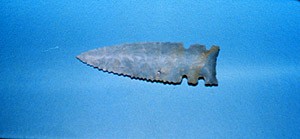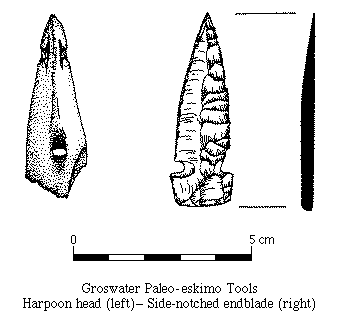Groswater Paleoeskimo
Port au Choix National Historic Site

Groswater blade exhibit at Port au Choix Visitor Centre
©Parks Canada
About 2800 years before present (B.P.), several hundred years after the Maritime Archaic Indians had abandoned the area, the Groswater Paleoeskimos arrived at Port au Choix. These people originating from the Arctic may have moved south to Newfoundland during a period of climatic cooling. Coming from the Arctic, the Groswater Paleoeskimos may have been culturally better adapted and had better technology to exploit the marine resources during a period of a colder climate.
The Groswater Paleoeskimos were even more marine focussed than the Maritime Archaic Indians. Their tools were for hunting marine animals such as seals and were distinctive in their smallness and fine craftsmanship. To date their unique bone, ivory and antler harpoon heads have only been found at Port au Choix .

Groswater Paleoeskimo tools, (left) Harpoon head, (right) Side-notched endblade
©Parks Canada
With these tools, including the distinctive side-notched harpoon endblades, the Groswater Paleoeskimos returned to Port au Choix every spring to hunt seals. They would set up camp at Phillip's Garden, near where modern-day seal hunters take off by boat. Excavations of the Groswater Palaeoeskimo camps at Phillip's Garden East and Phillip's Garden West suggest that the Groswater occupied the sites only on a seasonal basis.
About 1900 years B.P. the Groswater Paleoeskimos disappeared from this site and seemingly from history itself. Perhaps these people were displaced or assimilated by the newly arriving Dorset Paleoeskimos. Another idea suggests the Groswater were ancestral to the Dorset Paleoeskimos. There is simply not enough evidence to make an absolute conclusion about the fate of the Groswater Paleoeskimos and archaeologists continue to disagree on this point.
- Date modified :